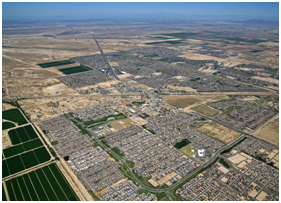The Challenge
How can a school district that has tripled in size since 2000 effectively develop a “career and college ready” student who’s steeped in STEM learning?
As the director of instructional technology in a district with a very limited budget and an increasing student enrollment, Michelle Benham has had to get creative about finding strong, yet affordable, programs that can build into her district’s vision for developing a “21st-century” learner.
In addition to instilling students with the 4Cs (critical thinking, collaboration, communication, and creativity), Dysart Unified officials want students to be well versed in STEM learning, the 3 Rs, and, said Benham, “all those skills necessary to be global citizens.”
Through Defined’s performance and literacy tasks, real-world connections, and career-based videos, Benham discovered she could meet her needs by:
- Applying the type of skills and knowledge Dysart Unified wanted students to have
- Purchasing at a price that the district could afford
The Solution
Incorporate Defined into the Dysart Unified curriculum for primary and elementary school grades to successfully integrate stronger math, science, and technology lessons among district students.
Benham researched several programs before selecting Defined. A big issue was her limited funding for any program Benham recalls, when she and the district curriculum director first learned about Defined at a meeting. They initially were impressed by Defined’s integration of STEM subjects within the context of real-world career or industry problems for students to solve.

Benham and the district curriculum director thought Defined was a fantastic resource that would be great for their district. Then, they instantly thought they couldn’t afford it. “Then we heard the price and we said, ‘We can buy that.’ ”
Now, each of the district’s elementary schools, from grades K–8, uses Defined, with most of use in grades 3–8. Students and teachers benefit from Defined’s career-based, application of knowledge platform that connects K-12 STEM subjects to the real world.
For example, in Rachel Kelley’s fifth-grade class at Surprise Elementary School, students have been working on engineering techniques, scientific research, and the science of how music affects the brain. “The best part of Defined is the variety of options for projects,” says Kelley. “There are a variety of topics and projects that can be done. There are prompts that I would have never thought of that are very motivating to students.”
Kelley said that her students now want to research much more and are asking to do projects they’ve seen other students doing. Defined has also made planning lessons easier for Kelley. “I use the prompt to start discussions with my students and they can use the resources provided to learn about the subject before doing research on their own.”
Benham notes that, overall, there is also an increased sense of enthusiasm in the schools.
“When I see Defined in action in the classrooms, I see that the students are highly engaged, they’re working with their peers, brainstorming ideas, and creating projects,” she says. “They’re excited about sharing ideas about the projects they’ve created or whatever point they’re at in doing their projects.”
Teachers in Dysart Unified also are experiencing some changes by using Defined. Because it’s a project-based and problem-based learning resource, teachers find that using Defined saves them hours in planning time. As well, the program already has quality performance tasks the teachers want their students engaged in.
“I like that we are able to edit the project and rubric options,” says Kelley. “This allows us to facilitate learning while still having some control over what students are doing especially when certain students need differentiation.”
The program is helping the district get closer to realizing its goal of ensuring every student fulfills the Dysart graduate profile. According to the profile, each Dysart graduate should be career and college-ready, a global citizen, and a critical thinker among other characteristics.
“Everything we do aligns to creating the Dysart Graduate, and Defined really fits into this,” says Benham. “We’re able to use Defined within lessons to further develop these skills in our students.”
To that end, district leaders are looking into expanding Defined to the high school level. Says Benham, “We’re excited by what we’re seeing.”